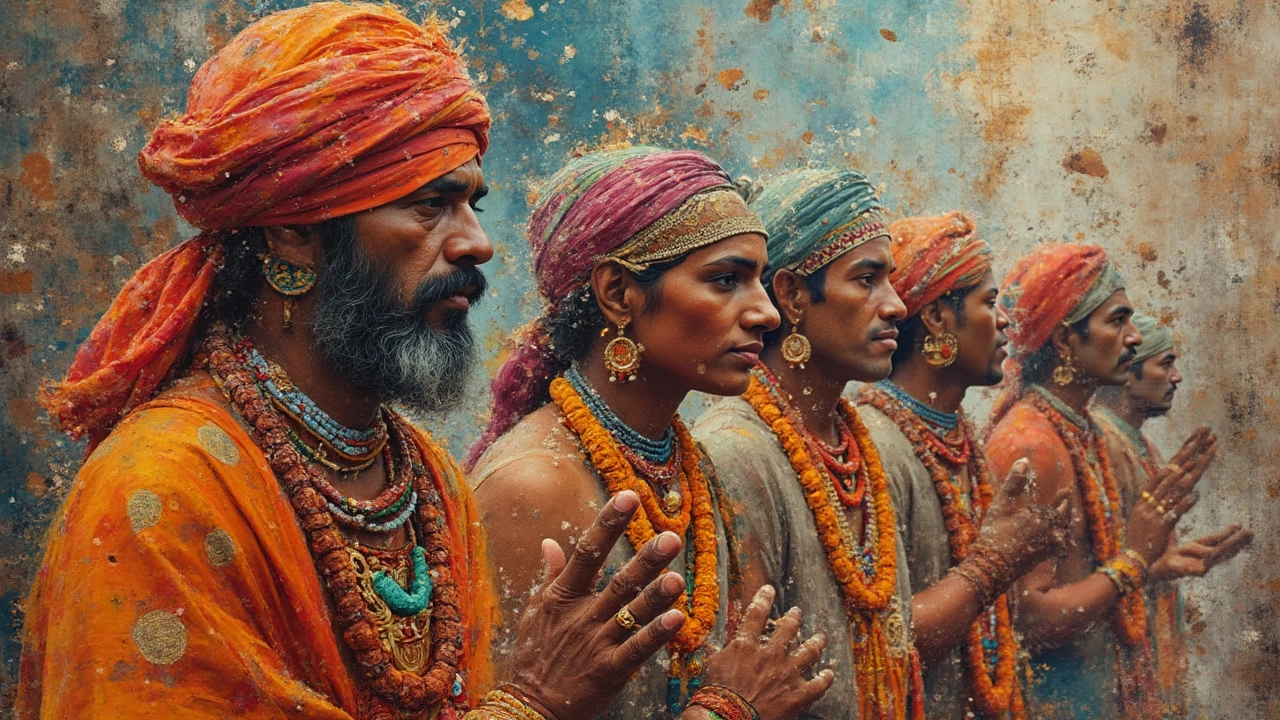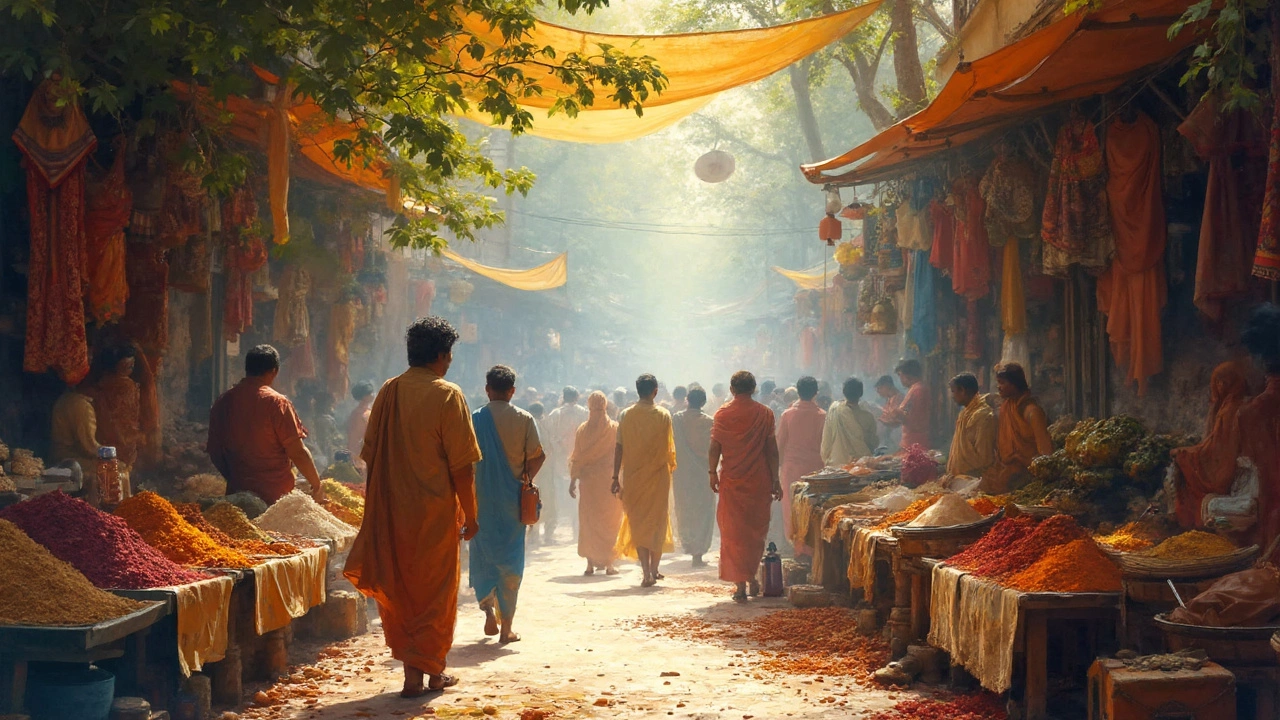Exploring India's Diversity: What's the Real Quote?

When it comes to diversity, India is like a living mosaic—vivid, complex, and dynamic. The phrase 'unity in diversity' is more than just a slogan here; it practically guides the country's day-to-day life. Imagine over 1.4 billion people speaking more than 22 official languages and countless regional dialects, celebrating hundreds of festivals across various religions, and indulging in a mind-boggling variety of cuisines. Now that's diversity for you!
But what does a diversity quote really mean in the Indian context? It's not just about the numbers. While numbers paint a picture, the real value lies in how different cultures interact harmoniously. It's about understanding, tolerance, and acceptance—a tapestry woven through the smallest villages to the largest cities.
Not only do these differences give India its unique identity, but they also offer a lesson on the importance of coexistence. It doesn't matter if you're munching on street food in Delhi or visiting a temple in Varanasi, everywhere you go, you're greeted with a different slice of this incredible cultural pie.
- India: A Tapestry of Cultures
- Languages and Dialects
- Festivals and Celebrations
- Cuisine: A Culinary Journey
- Living Diversity: Harmony and Challenges
India: A Tapestry of Cultures
India isn't just a country; it's like a continent filled with its own distinct and vibrant cultures. From the snow-capped peaks of the Himalayas to the sun-kissed coasts of Kerala, the sheer variety of lifestyles and traditions is astounding. You'll find bustling markets in the North, serene backwaters in the South, and everything in between.
Let's talk about languages for a second. India officially recognizes 22 languages under its Constitution. But get this—there are over 19,500 dialects spoken across its length and breadth! Think of every state as a mini-country with its own language, customs, and vibe. It's this linguistic diversity that keeps the cultural wheel spinning.
The Magic of Festivals
Festivals in India are more than just holidays—they're massive cultural gatherings that show off the country's diversity. Whether it's Diwali, the festival of lights; Eid-ul-Fitr, marking the end of Ramadan; or Pongal, a harvest festival in Tamil Nadu, each celebration brings its own set of traditions and flavors. And yes, they are as colorful and lively as they sound!
Religious Harmony
India's religious mix is like a spiritual buffet. You'll find Hindus, Muslims, Christians, Sikhs, Buddhists, and many others living side by side. This very coexistence is a testimony to the country's inclusive nature. Not every place in the world sees such a mix flourish so well.
| Religion | Percentage of Population |
|---|---|
| Hinduism | 79.8% |
| Islam | 14.2% |
| Christianity | 2.3% |
| Sikhism | 1.7% |
Cultural richness stems not just from historical monuments or artifacts, but from everyday life. Take a walk down a marketplace, and you'll witness a live orchestra of languages, traditions, and beliefs playing in harmony.
In the end, the diversity of India isn't just numbers or statistics—it's a vibrant dance of cultures that has been going strong for centuries. And it's this intricate tapestry that makes India unique in a world that's increasingly leaning toward homogenization.
Languages and Dialects
India's linguistic landscape is as diverse as its culture, and it's one of the most striking examples of India's diversity. With the constitution recognizing 22 official languages, and hundreds of other languages and dialects in use, the country is a linguist's dream come true. From Hindi and Bengali to Tamil and Telugu, each language carries its own history and tradition.
Officially Recognized Languages
The Indian diversity shines through its languages. Hindi, written in the Devanagari script, is the most spoken language, serving as the primary tongue for about 41% of the population. Yet, English acts as a secondary official language, especially for government operations, bridging language gaps across regions.
Besides Hindi and English, languages like Bengali, Marathi, Telugu, Tamil, Gujarati, and Urdu are prominent, each spoken by millions. In states like Maharashtra, Marathi dominates, while Tamil Nadu sticks with Tamil. Each of these languages forms the lifeline for regional media, literature, and communication.
Dialects and Regional Variations
A step further into the realms of Indian linguistic cultural richness, you'll discover countless dialects. For instance, Hindi alone branches into Bhojpuri, Awadhi, and Maithili, to name a few. These dialects cater to specific regions, yet their boundaries often blur, revealing mutual influences and shared vocabulary.
These languages and dialects encompass every aspect of life, from casual daily talks to religious ceremonies, reinforcing the nation's multicultural existence.
Language and Identity
Language in India is more than mere communication; it's identity. Whether it's ancestral stories told in the mother tongue or modern slang picked up in urban areas, language shapes both personal and cultural identities. Life quotes in India often reference this bond, emphasizing its importance in India's social fabric.
With such linguistic diversity, knowing multiple languages or dialects isn't rare among Indians. It's a skill picked up naturally through daily interactions and a testament to the nation's cultural richness.
| Language | Speakers (in millions) |
|---|---|
| Hindi | 528.3 |
| Bengali | 97.2 |
| Tamil | 74 |
| Telugu | 71.5 |
Ultimately, India's vast range of languages and dialects embodies the true spirit of Indian diversity, showing how this cultural richness plays out in everyday conversations, art, and life as a whole.

Festivals and Celebrations
India is famous for its diversity, and nowhere is this more evident than in its festivals and celebrations. Each festival you'll encounter, whether big or small, is a vibrant expression of the country's rich cultural fabric.
Diwali: The Festival of Lights
Diwali, perhaps one of the most well-known Indian festivals, symbolizes the victory of light over darkness. Millions of lamps light up homes, streets, and skies, creating a magical atmosphere. Families gather, exchange sweets, and set off fireworks, making it an unforgettable spectacle.
Holi: The Festival of Colors
Then there's Holi, the festival of colors, which celebrates the arrival of spring. On this day, you can't walk a block without getting drenched in vibrant powders. It’s all about joy, unity, and celebrating life with colors and music.
Eid Celebrations
The Muslim community in India celebrates Eid with great enthusiasm. Families come together for prayers at mosques, followed by a lavish feast. Traditional dishes like biryani and sweet delicacies like sewai are shared among friends and family.
Christmas Cheers
In cities like Goa, Christmas is celebrated with as much fervor as anywhere else. Churches hold midnight masses, streets are adorned with beautiful decorations, and people of all backgrounds join in the festivities.
"India, a nation of festivals, where every festival is a season of joy and happiness." – Rakesh Sharma, Cultural Historian
From regional events to nationwide celebrations, these festivals show India's cultural richness and remind us of the shared values that unite us. They’re not just days marked on a calendar; they’re an experience, a way of life, and a testament to how diversity thrives beautifully in India.
Cuisine: A Culinary Journey
When you think about India's diversity, one of the tastiest examples is its cuisine. It's like a flavor rollercoaster with every region offering its own unique recipes and ingredients. From the spicy curries of the south to the butter-rich dishes of the north, there's a bit of something for everyone!
North Indian Delights
The north is famous for its rich and hearty dishes. Think butter chicken, naan, and paneer tikka. These meals are often cooked in a tandoor oven, giving them a distinct smoky flavor. And let's not forget about street food—Delhi's chaat is a must-try for any foodie visiting the city.
Southern Flavors
Head south and you'll encounter spicy, coconut-infused dishes. Here, rice isn't just a side dish—it's a main staple. Dishes like dosa, sambar, and coconut chutney will give your taste buds a fun ride. This region also thrives on spices, so expect bold flavors!
Western and Eastern Varieties
In the west, places like Gujarat offer vegetarian wonders like dhokla and theplas. Meanwhile, coastal areas deliver seafood galore with dishes like Goan fish curry. Heading to the east, you'll find sweets like rasgulla and sandesh in Bengal, perfect for anyone with a sweet tooth.
Local Ingredients and Cooking Methods
What makes Indian cuisine truly exciting is its use of local ingredients and traditional cooking methods. Many dishes are prepared with organic spices and herbs which not only enhance flavor but also have health benefits. Turmeric, for example, is not only a staple spice but also known for its anti-inflammatory properties.
| Region | Popular Dish |
|---|---|
| North | Butter Chicken |
| South | Dosa |
| West | Dhokla |
| East | Rasgulla |
In a nutshell, exploring Indian cuisine is like taking a culinary journey through the country itself. The vast array of flavors and dishes reflects not just the India diversity, but the innovative spirit and age-old traditions that make each meal an experience worth savoring.

Living Diversity: Harmony and Challenges
Living in a place as diverse as India comes with its own mix of benefits and challenges. It's not just about having a neighbor who speaks a different language or follows a different religion. The everyday interactions between different communities are what make India's diversity a living, breathing phenomenon.
Harmony in Diversity: Take the famous Dharavi neighborhood in Mumbai as an example. It's a place where Hindus, Muslims, and Christians not only live next door to each other but share meals, festivals, and celebrations. Whether it's Diwali or Eid, everyone joins in. This kind of cultural exchange is what makes the country feel like one big family, despite its vast differences.
Challenges of Coexistence: But, let's not paint an overly rosy picture. With diversity comes a fair share of challenges. Language barriers can sometimes lead to misunderstandings, and traditional customs may clash with modern viewpoints. Political debates often heat up over these issues, reflecting on a national scale what many communities experience locally.
Consider language as an example. While Hindi and English serve as official languages, many people feel more comfortable in their regional tongue. This can sometimes create barriers, especially in official settings like government offices or national exams. But it also pushes the country towards finding innovative solutions, like multilingual education systems that respect these differences. Here's a quick look:
| Language | Number of Speakers (in millions) |
|---|---|
| Hindi | 600 |
| Bengali | 97 |
| Telugu | 81 |
| Marathi | 84 |
Incorporating multiple languages into educational and governmental frameworks is just one way India addresses these challenges. And while it isn't perfect, the ongoing dialogue and efforts to improve are essential components of maintaining this 'unity in diversity'.